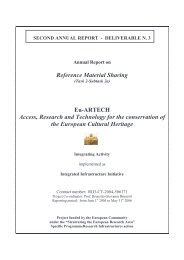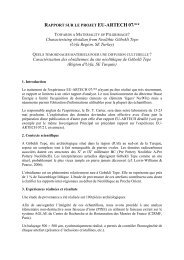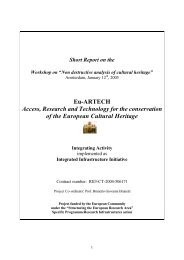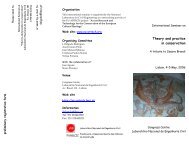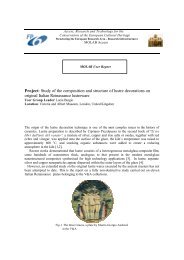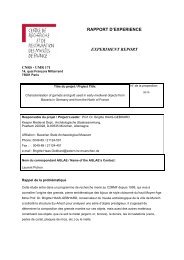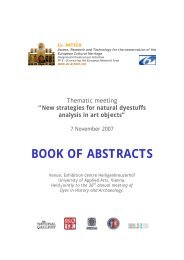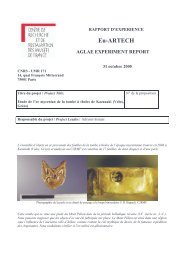Propolis (bee glue): an unusual mordant for gilding in Italian ... - Fir
Propolis (bee glue): an unusual mordant for gilding in Italian ... - Fir
Propolis (bee glue): an unusual mordant for gilding in Italian ... - Fir
Create successful ePaper yourself
Turn your PDF publications into a flip-book with our unique Google optimized e-Paper software.
<strong>Propolis</strong> (<strong>bee</strong> <strong>glue</strong>): <strong>an</strong> <strong>unusual</strong> mord<strong>an</strong>t <strong>for</strong> <strong>gild<strong>in</strong>g</strong> <strong>in</strong> Itali<strong>an</strong> renaiss<strong>an</strong>ce<br />
pa<strong>in</strong>t<strong>in</strong>gs?<br />
Cather<strong>in</strong>e Higgitt, National Gallery, London, WC2N 5DN, cather<strong>in</strong>e.higgitt@ng-london.org.uk<br />
Dur<strong>in</strong>g the recent conservation treatment of a group of three spalliere p<strong>an</strong>els pa<strong>in</strong>ted around 1494<br />
by the <strong>an</strong>onymous pa<strong>in</strong>ter known as the Master of the Story of Griselda, we had the opportunity to<br />
study these p<strong>an</strong>els <strong>in</strong> detail <strong>an</strong>d <strong>an</strong> <strong>unusual</strong> thick, yellowish, unpigmented mord<strong>an</strong>t was noticed <strong>in</strong><br />
areas of mord<strong>an</strong>t <strong>gild<strong>in</strong>g</strong> <strong>in</strong> all three p<strong>an</strong>els. An extremely similar mord<strong>an</strong>t was found <strong>in</strong> <strong>an</strong>other<br />
work thought to be by the Master of the Story of Griselda, a pa<strong>in</strong>t<strong>in</strong>g of Alex<strong>an</strong>der the Great, from<br />
the Barber Institute <strong>in</strong> Birm<strong>in</strong>gham. It was also found <strong>in</strong> a work by the Perugi<strong>an</strong> artist Gi<strong>an</strong>nicola di<br />
Paolo, <strong>an</strong>d <strong>in</strong> two, slightly earlier, Northern Itali<strong>an</strong> works by Giambono <strong>an</strong>d Vivar<strong>in</strong>i.<br />
Cross-section taken from area of mord<strong>an</strong>t <strong>gild<strong>in</strong>g</strong> from the<br />
Master of the Story of Griselda, The Story of Patient Griselda,<br />
Part III Reunion (NG 914), c. 1493-1500<br />
Gold leaf was used by Renaiss<strong>an</strong>ce artists <strong>in</strong> a variety of ways. Where a highly burnished, reflective<br />
f<strong>in</strong>ish was required water <strong>gild<strong>in</strong>g</strong> was used, with a bole layer (a soft iron-conta<strong>in</strong><strong>in</strong>g clay <strong>in</strong> Italy or<br />
<strong>an</strong> iron oxide mixture <strong>in</strong> Northern Europe) bound with size (<strong>glue</strong>). The bole layer imparts a warm<br />
colour to the th<strong>in</strong> gold leaf <strong>an</strong>d provides a smooth, slightly yield<strong>in</strong>g cushion aga<strong>in</strong>st which to<br />
burnish the gold, or to add punched or <strong>in</strong>cised detail.<br />
However <strong>for</strong> f<strong>in</strong>e details mord<strong>an</strong>t <strong>gild<strong>in</strong>g</strong> was used which <strong>in</strong>volves apply<strong>in</strong>g small pieces of gold<br />
leaf on to <strong>an</strong> adhesive or mord<strong>an</strong>t previously applied to the areas to be decorated. Various materials<br />
have <strong>bee</strong>n used as mord<strong>an</strong>ts, but they are usually yellowish <strong>in</strong> colour <strong>an</strong>d should dry quickly to<br />
allow the mord<strong>an</strong>t to become sufficiently tacky <strong>for</strong> the gold to adhere. Most documentary sources,<br />
<strong>in</strong>clud<strong>in</strong>g Cenn<strong>in</strong>o Cenn<strong>in</strong>i, gives recipes <strong>for</strong> <strong>an</strong> oil-based mord<strong>an</strong>t based on thickened <strong>an</strong>d prepolymerised<br />
l<strong>in</strong>seed oil mixed with a variety of pigments, of which several are always good driers.<br />
The addition of a little varnish is sometimes mentioned also. Mord<strong>an</strong>t<strong>gild<strong>in</strong>g</strong> has a yellower, more<br />
matt surface th<strong>an</strong> water <strong>gild<strong>in</strong>g</strong>. Other possible adhesives <strong>for</strong> gold are described <strong>in</strong> the sources<br />
(although some perhaps describe methods <strong>for</strong> m<strong>an</strong>uscript illum<strong>in</strong>ation rather th<strong>an</strong> p<strong>an</strong>el pa<strong>in</strong>t<strong>in</strong>g)<br />
<strong>in</strong>clud<strong>in</strong>g egg white, gum, size (or <strong>glue</strong>) or garlic juice mixed with a little bole <strong>an</strong>d lead white<br />
(described by Cenn<strong>in</strong>o <strong>an</strong>d others).<br />
In some areas <strong>in</strong> the National Gallery p<strong>an</strong>els the yellowish unpigmented mord<strong>an</strong>t was applied over<br />
<strong>an</strong> or<strong>an</strong>ge-brown base pa<strong>in</strong>t (composed of or<strong>an</strong>ge earth pigment, vermilion <strong>an</strong>d lead white <strong>in</strong> oil),<br />
while <strong>in</strong> other areas it was applied directly onto the azurite pa<strong>in</strong>t layer or onto the gesso. When the<br />
mord<strong>an</strong>t was exam<strong>in</strong>ed by EDX <strong>an</strong>alysis, no <strong>in</strong>org<strong>an</strong>ic material was detected <strong>in</strong> the region of the<br />
mord<strong>an</strong>t. When exam<strong>in</strong>ed by FTIR microscopy, a very unexpected spectrum was obta<strong>in</strong>ed which<br />
did not correspond to <strong>an</strong>y of the oil, prote<strong>in</strong>aceous or carbohydrate-based materials mentioned <strong>in</strong><br />
the sources. The IR spectra <strong>in</strong>stead suggest that the mord<strong>an</strong>t is composed of esters of aromatic acids<br />
<strong>an</strong>d polyphenolic compounds.<br />
The mord<strong>an</strong>t conta<strong>in</strong>ed little or no fatty acids, no wax components <strong>an</strong>d no di- or triterpenoid res<strong>in</strong><br />
components when exam<strong>in</strong>ed by GC-MS <strong>an</strong>alysis (after derivatisation with TMTFTH). However, a
number of compounds were detected based on hydroxy or methoxy benzoic acids.<br />
Mass spectral data: (TMTFTH derivatisation)<br />
Retention time/m<strong>in</strong>s B + , M + Component<br />
24.7, 25.2, 25.4 360, 165 Benzoate ester of substituted aromatic alcohol?<br />
23.6, 23.7 358, 165 Dehydrogenated benzoate ester of substituted aromatic<br />
alcohol?<br />
15.8 196, 165 Dimethoxybenzoic acid methyl ester<br />
14.1 150, 182 Methyl 4-methoxysalicylate<br />
12.7 135, 166 Methoxybenzoic acid, methyl ester<br />
One material which is rich <strong>in</strong> polyphenolic components, is sticky <strong>an</strong>d would have <strong>bee</strong>n available to<br />
artists is propolis (although there appear to be no documentary reference to it use <strong>in</strong> artworks).<br />
<strong>Propolis</strong>, which is also known as <strong>bee</strong> <strong>glue</strong>, is a chemically complex sticky, dark-coloured res<strong>in</strong>ous<br />
hive product conta<strong>in</strong><strong>in</strong>g material collected by <strong>bee</strong>s from buds or other pl<strong>an</strong>t exudates, volatile<br />
subst<strong>an</strong>ces <strong>an</strong>d <strong>bee</strong>swax. It is used by <strong>bee</strong>s as a seal<strong>an</strong>t <strong>an</strong>d to protect the nest aga<strong>in</strong>st microorg<strong>an</strong>isms.<br />
Both Aristotle <strong>an</strong>d Pl<strong>in</strong>y give accounts of propolis – mention<strong>in</strong>g its medic<strong>in</strong>al properties.<br />
Interest <strong>in</strong> the material has revived <strong>for</strong> medical use <strong>an</strong>d much work has <strong>bee</strong>n done on the chemical<br />
composition because it has <strong>bee</strong>n shown to exhibit <strong>an</strong>tibacterial, <strong>an</strong>tiviral, <strong>an</strong>ti-<strong>in</strong>flammatory,<strong>an</strong>tioxid<strong>an</strong>t<br />
etc properties. The studies have shown that propolis is a very complex mixture of<br />
components – ma<strong>in</strong>ly polyphenols <strong>in</strong>clud<strong>in</strong>g flavonoids, phenolic acids <strong>an</strong>d esters of aromatic<br />
alcohols, but also fatty acids, hydrocarbons <strong>an</strong>d terpenes.<br />
NG 914 Master of the Story of<br />
Griselda<br />
Crude propolis, Umbri<strong>an</strong>, 2005,<br />
via B. Brunetti<br />
<strong>Propolis</strong> (alcohol solubles)<br />
1977, via Fellgett<br />
<strong>Propolis</strong> (alcohol solubles)<br />
2005, Umbri<strong>an</strong>, via B. Brunetti<br />
Beeswax, Umbri<strong>an</strong>, 2005, via B.<br />
Brunetti<br />
Absorb<strong>an</strong>ce<br />
1850<br />
1650<br />
1450<br />
1250<br />
wavenumber (cm -1 )<br />
<strong>Propolis</strong> samples give IR spectra that are close to that <strong>for</strong> the mord<strong>an</strong>t samples, although there are<br />
some m<strong>in</strong>or differences. The composition as determ<strong>in</strong>ed by GC-MS <strong>an</strong>alysis is more divergent<br />
however. What is strik<strong>in</strong>g is that propolis samples tend to show a parallel series of benzoic <strong>an</strong>d<br />
phenylpropenoic (c<strong>in</strong>namic) acids <strong>an</strong>d esters with hydroxy <strong>an</strong>d methoxy substituents but only<br />
benzoic acid derivatives were found <strong>in</strong> the mord<strong>an</strong>t samples.<br />
These differences could result from the highly variable nature of propolis, or may be l<strong>in</strong>ked to<br />
ch<strong>an</strong>ges that occur on age<strong>in</strong>g. It is possible that the phenylpropenoic acids <strong>an</strong>d esters could crossl<strong>in</strong>k.<br />
If cross-l<strong>in</strong>k<strong>in</strong>g occurs then this might expla<strong>in</strong> why only benzoic acid derivatives were<br />
detected <strong>in</strong> the mord<strong>an</strong>t samples.<br />
Of course <strong>an</strong> alternative expl<strong>an</strong>ation is that the mord<strong>an</strong>t is not proplis. Other materials that are also<br />
rich <strong>in</strong> esters of benzoic <strong>an</strong>d c<strong>in</strong>namic acids (with correspond<strong>in</strong>g aromatic alcohols) <strong>in</strong>clude various<br />
1050<br />
850<br />
650
alsamic res<strong>in</strong>s (such as gum benzo<strong>in</strong> <strong>an</strong>d storax res<strong>in</strong>). Aga<strong>in</strong> these materials were <strong>in</strong>troduced early<br />
<strong>in</strong>to Europe, but probably as medic<strong>in</strong>es or as cosmetics or perfumes <strong>an</strong>d have also not <strong>bee</strong>n<br />
encountered be<strong>for</strong>e as mord<strong>an</strong>ts. The IR spectra of the mord<strong>an</strong>t samples show similarities to those<br />
of various balsamic res<strong>in</strong>s, but the match is not exact.<br />
Further work is required to fully identify this <strong>unusual</strong> mord<strong>an</strong>t material, <strong>in</strong>clud<strong>in</strong>g a study of the<br />
ch<strong>an</strong>ges that occur when propolis <strong>an</strong>d balsamic res<strong>in</strong>s age. If suitable mord<strong>an</strong>t samples from<br />
pa<strong>in</strong>t<strong>in</strong>gs become available, it is also <strong>in</strong>tended to try further GC-MS <strong>an</strong>alysis (us<strong>in</strong>g silylation but<br />
avoid<strong>in</strong>g sample hydrolysis) <strong>an</strong>d to try py-GC-MS <strong>an</strong>alysis.<br />
References:<br />
D. Bom<strong>for</strong>d, J. Dunkerton, D. Gordon, A. Roy, Art <strong>in</strong> the Mak<strong>in</strong>g: Itali<strong>an</strong> Pa<strong>in</strong>t<strong>in</strong>g be<strong>for</strong>e 1400,<br />
National Gallery Comp<strong>an</strong>y<br />
National Gallery Technical Bullet<strong>in</strong>, Early Northern Europe<strong>an</strong> Pa<strong>in</strong>t<strong>in</strong>g, Vol. 18, 1997<br />
I. Bonaduce, M.P. Colomb<strong>in</strong>i <strong>an</strong>d S. Dir<strong>in</strong>g, ‘Identification of garlic <strong>in</strong> old <strong>gild<strong>in</strong>g</strong> by gas<br />
chromatography-mass spectrometry’, J. of Chromatography. A, 2006, 1107, pp. 226-232<br />
C. Christensen, J. Dunkerton <strong>an</strong>d L. Syson, ‘The Master of the Story of Griselda <strong>an</strong>d pa<strong>in</strong>t<strong>in</strong>gs <strong>for</strong><br />
Sienese palaces’, National Gallery Technical Bullet<strong>in</strong>: Renaiss<strong>an</strong>ce Siena <strong>an</strong>d Perugia 1490-1510,<br />
26, 2007<br />
J. Mills <strong>an</strong>d R. White, The Org<strong>an</strong>ic Chemistry of Museum Objects, Butterworth-He<strong>in</strong>em<strong>an</strong>n, 1984<br />
W. Greenaway, T. Scaysbrook <strong>an</strong>d F.R. Whatley, ‘The <strong>an</strong>alysis of the bud exudates of Populus x<br />
eurameric<strong>an</strong>a <strong>an</strong>d of propolis, by gas chromatography-mass spectrometry’, Proc. R. Soc. Lond. B,<br />
1987, 232, pp. 249-272<br />
V. B<strong>an</strong>kova, ‘Recent trends <strong>an</strong>d import<strong>an</strong>t developments <strong>in</strong> propolis research’, eCAM, 2005, 2(1),<br />
pp. 29-32



